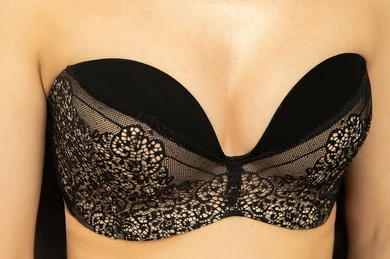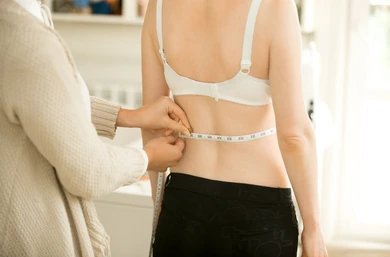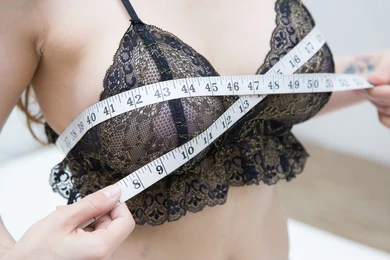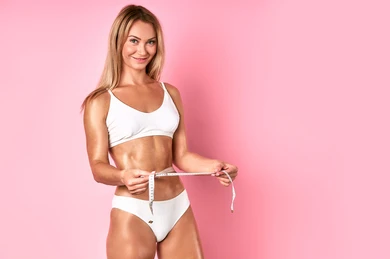The Bra Size Calculator is a helpful tool that can assist you in determining your correct bra size. Finding the perfect bra size is essential for comfort and proper support, and using a calculator can simplify the process. In this guide, we will explain how to use a Bra Size figure Calculator effectively, ensuring that you can find the ideal fit for your body. Follow the steps below to measure yourself accurately and obtain your correct bra size.
Understanding Bra Size Calculator in Detail
1. The Importance of Bra Sizing:
Wearing the correct bra size is vital for both comfort and support. A well-fitting bra not only enhances your appearance but also promotes good breast health. It provides the necessary support to minimize strain on your back, shoulders, and breast tissue. Wearing an ill-fitting bra, on the other hand, can lead to discomfort, pain, and potential long-term health issues. Understanding bra sizing helps you find the perfect fit, ensuring optimal comfort and support throughout the day.
2. Band Size:
The band size refers to the measurement around your underbust, just below the breasts. It determines the foundation of your bra’s fit. To measure your band size accurately, wrap a measuring tape snugly around your underbust, ensuring it sits parallel to the floor. Take note of the measurement in inches or centimeters. Band sizes typically range from 28 to 46, although variations may exist among different brands and regions.
3. Cup Size:
The cup size refers to the volume of your breasts and is determined by the difference between your band size and bust measurement. To measure your bust size, wrap the measuring tape around the fullest part of your breasts, making sure it remains parallel to the floor. Subtract your band size measurement from your bust measurement to determine your cup size. Each inch or centimeter difference corresponds to a different cup size (e.g., 1 inch = A cup, 2 inches = B cup, and so on).
4. Sister Sizing:
Sister sizing refers to the concept that different bra sizes can have similar cup volumes but varying band sizes. For example, if your usual bra size is 34C, your sister sizes would be 36B (larger band, smaller cup) and 32D (smaller band, larger cup). Sister sizing can be useful when trying on bras from different brands or when accommodating personal preferences for band tightness or cup shape.
5. Different Sizing Systems:
Bra sizing can vary among different regions and countries. The most commonly used systems are the US, UK, and EU sizing systems. It’s important to understand the differences and conversions between these systems to ensure accurate sizing and to choose bras accordingly. Conversion charts and online tools can help you navigate between sizing systems.
6. Factors Affecting Bra Size:
It’s essential to keep in mind that bra size can change over time due to various factors, including weight fluctuations, pregnancy, hormonal changes, and aging. Regularly assessing and remeasuring yourself can help you stay updated with your current size and ensure a comfortable fit.
By understanding the fundamentals of bra sizing, you can navigate the process of finding the perfect bra fit with confidence. Remember to consider both band size and cup size, explore sister sizes, and be aware of the variations among sizing systems. Regular measurements and adjustments will help you maintain comfort, support, and overall breast health.
Choosing a Bra Size Calculator
1. Types of Bra Size Figure Calculators:
There are several options available when it comes to choosing a Bra Size Calculator. Understanding the different types can help you select the one that suits your needs:
a. Online Calculators: Online Bra Size Calculators are widely accessible and convenient to use. They typically require you to enter your measurements into a web form or select from predefined options. These calculators often provide instant results, suggesting your bra size based on the input provided.
b. Mobile Apps: Many mobile apps are available that offer Bra Size Figure Calculators. These apps may provide additional features, such as virtual try-ons, style recommendations, and the ability to save your measurements for future reference. Mobile apps can be particularly useful if you prefer using your smartphone or tablet for convenience.
c. Offline Methods: In addition to online calculators and mobile apps, you can also find Bra Size Calculators in the form of printed measurement charts or guides. These charts typically consist of diagrams and instructions for manually measuring your underbust and bust size. While they may require a bit more effort and accuracy on your part, offline methods can be useful if you prefer a non-digital approach.
Features to Consider:
- When choosing a Bra Size Calculator, consider the following features:
a. Accuracy: Look for calculators that are known for their accuracy and reliability. Check for user reviews or recommendations from reputable sources to ensure that the calculator provides accurate sizing suggestions.
b. Measurement Options: A good calculator should allow you to input various measurements, including underbust, bust, and possibly other parameters like cup shape or breast fullness. The more comprehensive the measurement options, the more accurate the sizing recommendation is likely to be.
c. Conversion Capability: If you plan to shop for bras from different regions or brands, it can be helpful to choose a calculator that offers conversions between different sizing systems (e.g., US, UK, EU). This ensures that you can easily find the equivalent size in different regions, increasing your options when shopping.
d. User-Friendly Interface: A well-designed calculator should have a user-friendly interface that is easy to navigate and understand. Clear instructions, intuitive input fields, and visual aids can enhance the usability and accuracy of the calculator.
e. Additional Resources: Some calculators or platforms may provide additional resources, such as fit guides, bra style recommendations, or tips for measuring. These can be helpful, especially if you are new to bra sizing or seeking guidance on finding the right fit and style.
Recommendations and Research:
- Before settling on a specific Bra Size Calculator, it is recommended to do some research. Look for calculators that are backed by reputable lingerie brands, experts, or organizations specializing in bra fitting. Check for customer reviews and testimonials to gauge the overall satisfaction and accuracy of the calculator. Additionally, consider trying out multiple calculators or methods to compare results and ensure consistency.
By considering the different types of Bra Size Figure Calculators available, evaluating their features, and conducting research, you can choose a reliable calculator that will help you accurately determine your bra size. Remember that a good calculator should offer accuracy, comprehensive measurement options, conversion capabilities, a user-friendly interface, and potentially additional resources for a well-rounded bra sizing experience.
Measuring Yourself
Topwear provided map of bra size calculator and Accurate measurements are crucial when determining your bra size. By following these step-by-step instructions, you can ensure that your measurements are precise, leading to a more accurate sizing result.
-
Gather the necessary tools:
- Soft measuring tape: Choose a flexible tape measure that can easily wrap around your body.
- Mirror: Having a mirror nearby will help you maintain proper posture and ensure accurate measurements.
- Notepad and pen: Keep these handy to jot down your measurements and any additional notes.
-
Underbust Measurement:
- Stand in front of a mirror and position the measuring tape around your ribcage, just beneath your breasts.
- Ensure the tape is snug but not too tight, and keep it parallel to the floor.
- Take note of the measurement in inches or centimeters.
-
Bust Measurement:
- Wrap the measuring tape around the fullest part of your breasts, making sure it rests parallel to the floor.
- Avoid pulling the tape too tight or letting it sag.
- Note down the measurement.
-
Additional Measurements:
- While not essential, you may choose to take additional measurements to enhance the accuracy of your bra size calculation.
- Breast shape: Determine your breast shape by observing whether they are fuller on the top, bottom, or evenly distributed.
- Breast spacing: Measure the distance between the center of your breasts to understand how they are positioned in relation to each other.
-
Recheck and Remeasure:
- To ensure accuracy, double-check your measurements and, if necessary, remeasure any areas that may seem inconsistent.
- It’s important to stand tall and maintain good posture throughout the measuring process.
-
Inputting Measurements into the Calculator:
- Once you have your measurements, input them into the selected Bra Size Calculator, whether it’s an online tool, mobile app, or offline chart.
- Follow the instructions provided by the calculator, entering your underbust and bust measurements accurately.
-
Interpreting the Results:
- The Bra Size Calculator will generate a recommended bra size based on your measurements.
- Pay attention to both the band size and cup size suggested by the calculator.
- Keep in mind that different brands and countries may have slight variations in sizing, so consider trying on bras in different sizes to find your best fit.
-
Adjusting for Personal Preferences:
- While the calculator’s results provide a good starting point, personal preferences play a significant role in finding the perfect fit.
- Consider factors like how snug you prefer the band to be, cup shape preferences, and any specific requirements for different outfits or activities.
Remember, accurate measurements are the foundation for finding the right bra size. Take your time, follow the instructions carefully, and don’t hesitate to remeasure if needed. The more precise your measurements, the better chance you have of finding a bra that offers optimal comfort and support.

Entering the Measurements for Bra size Calculator
Once you have taken your underbust and bust measurements accurately, it’s time to enter them into the Bra Size Figure Calculator. Whether you’re using an online tool, a mobile app, or an offline chart, the process generally involves inputting the measurements to receive a suggested bra size. Here are the steps for entering your measurements effectively:
-
Identify the Input Fields:
- Open the Bra Size Calculator you have chosen, ensuring that you have a clear view of the input fields.
- Look for specific fields where you can enter your underbust and bust measurements. These fields are typically labeled or clearly indicated.
-
Choose the Correct Units:
- Check whether the calculator requires measurements in inches or centimeters.
- Make sure you enter the measurements in the appropriate unit to obtain accurate results.
-
Enter the Underbust Measurement:
- Locate the field designated for the underbust measurement.
- Carefully type in or select the numerical value that corresponds to your underbust measurement.
- Ensure that you enter the measurement accurately without rounding up or down.
-
Enter the Bust Measurement:
- Locate the field designated for the bust measurement.
- Enter the numerical value that corresponds to your bust measurement.
- Again, make sure to enter the measurement accurately without rounding.
-
Additional Parameters:
- Some calculators may ask for additional parameters, such as breast shape or spacing, to provide a more customized recommendation.
- If the calculator asks for these details, follow the instructions provided and enter the relevant information accurately.
-
Verify the Entered Measurements:
- Before proceeding, double-check the values you entered for both the underbust and bust measurements.
- Ensure that you haven’t made any typos or transposed the digits.
- Confirm that the measurements accurately reflect what you measured earlier.
-
Calculate or Submit:
- Once you are confident that the measurements are correct, look for a button or option to calculate or submit the data.
- Click or select the appropriate action to initiate the calculation process.
-
Review the Results:
- After submitting your measurements, the Bra Size Calculator will generate a suggested bra size based on the input provided.
- Take note of both the band size and the cup size recommended by the calculator.
- It is common for the size to be presented as a combination of a numerical band size and a letter cup size (e.g., 34C, 36D).
-
Adjust and Explore:
- Keep in mind that the suggested size is a starting point, and personal preferences and variations between brands may influence your final choice.
- Use the calculated size as a guide but be open to trying different sizes, especially if you encounter fit issues or discomfort.
- Explore bras in nearby sizes or sister sizes to find the best fit for your unique body shape and preferences.
Entering the measurements accurately into the Bra Size Figure Calculator is crucial for obtaining reliable results. Take your time, double-check the values, and ensure that you are using the correct units. The calculated size will serve as a helpful reference point, but don’t hesitate to adjust and experiment to find the perfect fit.
Interpreting the Results
Once you have entered your measurements into the Bra Size Calculator and received the suggested bra size, it’s important to understand how to interpret the results. Here are some key points to consider when interpreting the calculator’s recommendations:
-
Band Size:
- The suggested band size represents the measurement around your underbust.
- It is typically represented by a numerical value, such as 32, 34, 36, etc.
- This measurement determines the band’s snugness and stability, providing the foundation of support for your bra.
- Keep in mind that different brands and styles may have slight variations in band sizing, so you may need to try different sizes to find the one that fits you best.
-
Cup Size:
- The suggested cup size represents the volume of your breasts in relation to your band size.
- It is typically represented by a letter, such as A, B, C, D, etc.
- The cup size indicates how much room the bra’s cups will provide to accommodate your breasts.
- As the band size changes, the cup size also changes proportionately. For example, a 32C cup is smaller in volume than a 34C cup but larger than a 30C cup.
- It’s important to note that cup sizes are not standardized across all brands, so you may need to try different sizes to find the cup size that fits your breasts best.
-
Sister Sizes:
- Sister sizes refer to different band sizes with equivalent cup volumes. For example, if the calculator suggests a 34C bra size, the sister size options would be a 32D (smaller band, larger cup) or a 36B (larger band, smaller cup).
- Understanding sister sizes can be helpful when trying on bras from different brands or when adjusting for personal preferences regarding band tightness or cup shape.
- Keep in mind that while sister sizes have equivalent cup volumes, the fit and shape of the cups may vary due to differences in band tension and overall bra construction.
-
Fit Considerations:
- The suggested bra size serves as a starting point, but individual fit preferences and body variations may require adjustments.
- Pay attention to how the bra feels when you try it on. Assess the band snugness, cup coverage, and overall comfort.
- If the band feels too tight or too loose, consider trying a sister size with a slightly different band measurement.
- If the cups feel too small or too large, try adjusting the cup size accordingly.
- Remember that different bra styles, such as balconette, plunge, or full-coverage bras, may fit differently even in the same size. Experiment with different styles to find the ones that suit you best.
-
Professional Fittings:
- While Bra Size Figure Calculators can provide helpful guidance, a professional fitting from a bra specialist can offer additional insights and expertise.
- Consider visiting a lingerie store or boutique that offers professional fittings to further refine your bra size and ensure the best fit possible.
Interpreting the results of the Bra Size Calculator requires careful consideration of both the band size and cup size recommendations. Keep in mind that personal fit preferences, brand variations, and different bra styles may influence your final choice. Adjustments may be necessary to achieve optimal comfort and support. Remember that finding the right bra size is an ongoing process, and it’s worth trying different sizes and styles to discover the perfect fit for your unique body shape.
Trying on Bras
Trying on bras is an essential part of the bra fitting process, as it allows you to assess the fit, comfort, and support provided by different styles and sizes. Here are some tips to make the most out of your bra try-on experience:
-
Start with the Recommended Size:
- Begin by trying on bras in the size suggested by the Bra Size Calculator or the measurement guide you used.
- Use this size as a starting point, but be open to trying nearby sizes or sister sizes to find the best fit for your unique body shape.
-
Choose Different Styles:
- Experiment with different bra styles to understand which ones work best for you.
- Common styles include balconette, plunge, full-coverage, push-up, sports bras, and more.
- Each style offers different levels of coverage, lift, and shaping, so try a variety of styles to find the ones that suit your preferences and needs.
-
Pay Attention to Band Fit:
- Start by fastening the bra on the loosest hook to allow for adjustments over time as the bra stretches with wear.
- Check the band fit by sliding two fingers under the band. It should feel snug and provide support without digging into your skin or feeling too loose.
- If the band feels too tight or too loose, try a different band size or adjust the hook settings.
-
Assess Cup Coverage:
- Check the cup coverage by ensuring that your breasts are fully contained within the cups without any spillage or gaps.
- The cups should encapsulate your breasts smoothly, with no wrinkling or excess fabric.
- If the cups feel too small or too large, try a different cup size to achieve the ideal fit and shape.
-
Evaluate Underwire Placement and Comfort:
- If the bra has an underwire, ensure that it lies flat against your ribcage and encases your breasts fully without poking or digging into your skin.
- The underwire should follow the natural curve of your breasts and sit against your chest bone, providing support and lift.
-
Assess Shoulder Strap Comfort:
- The shoulder straps should provide support without digging into your shoulders or sliding off.
- Adjust the straps to a comfortable length that keeps the bra secure without causing discomfort or leaving marks on your skin.
-
Move and Test Support:
- Move around while wearing the bra to evaluate its support and comfort during various activities.
- Lift your arms, bend over, and perform movements that mimic your everyday activities to ensure the bra stays in place and provides the desired level of support.
-
Take Your Time:
- Be patient and take your time when trying on bras. It may require trying on several styles and sizes before finding the perfect fit.
- Don’t hesitate to ask for assistance from store staff if you need help or advice during the try-on process.
-
Trust Your Comfort and Confidence:
- Ultimately, trust your own comfort and confidence when selecting a bra.
- A well-fitting bra should feel comfortable, supportive, and boost your self-assurance.
Remember that bra sizing and fit can vary between brands and styles, so don’t be discouraged if you encounter discrepancies or inconsistencies. Be open to trying different sizes and styles, and trust your own judgment when it comes to the fit and feel of a bra.
Adjusting for Personal Preferences
While finding the right size is crucial, it’s equally important to consider your personal preferences when it comes to the fit and feel of a bra. Here are some factors to consider and adjustments you can make to ensure the bra meets your individual needs:
-
Band Snugness:
- Some individuals prefer a tighter or looser band fit based on their comfort level and support requirements.
- If you prefer a snugger fit, consider trying a band size smaller than the recommended size.
- If you prefer a more relaxed fit, try a band size larger than the suggested size.
- Remember that adjusting the band size may require corresponding changes in the cup size to maintain the same cup volume (e.g., going up a band size may require going down a cup size).
-
Cup Shape and Coverage:
- Different bra styles offer varying degrees of cup coverage and shaping.
- If you prefer a more lifted and rounded look, consider trying bras with padding, push-up features, or molded cups.
- If you prefer a more natural and minimally shaped silhouette, opt for bras with unlined or lightly lined cups.
- Experiment with different cup shapes (balconette, plunge, full-coverage, etc.) to find the one that flatters your breasts and meets your aesthetic preferences.
-
Strap Adjustments:
- The length and tightness of the shoulder straps can be adjusted according to your comfort and support needs.
- If the straps dig into your shoulders, try loosening them slightly or opting for bras with wider or padded straps.
- If the straps slip off your shoulders, tighten them or look for bras with adjustable and secure strap designs.
- Remember to keep the straps at a length that provides support without causing discomfort or leaving marks on your skin.
-
Closure Hooks:
- Most bras have multiple closure hooks to allow for adjustment as the bra stretches over time.
- Start with the loosest hook when trying on a new bra.
- As the bra stretches with wear, you can move to the tighter hooks to maintain a snug fit.
-
Different Brands and Styles:
- Each brand may have slight variations in sizing, fit, and comfort.
- Be open to trying bras from different brands and exploring various styles to find the ones that suit you best.
- Keep in mind that the same size in different brands may fit differently, so be prepared to try different sizes within a brand as well.
-
Activity-Specific Requirements:
- Consider your lifestyle and specific activities when selecting bras.
- If you engage in high-impact activities, such as running or aerobics, opt for sports bras that provide maximum support and minimize movement.
- If you need bras for everyday wear, choose styles that offer a balance of comfort, support, and versatility.
- Special occasions may call for bras with specific features, such as strapless or convertible options, to accommodate different outfit styles.
-
Comfort is Key:
- Above all, prioritize your comfort when adjusting for personal preferences.
- Pay attention to how the bra feels on your body throughout the day.
- If you experience discomfort, irritation, or red marks, it may be an indication that the bra requires further adjustment or a different size/style.
Remember that everyone’s preferences and body shapes are unique, so don’t be afraid to experiment and make adjustments until you find the bras that make you feel comfortable, confident, and well-supported. Trust your instincts and prioritize your personal comfort and satisfaction when selecting and adjusting bras.
Revisiting Your Bra Size
It’s important to periodically revisit your bra size to ensure that it continues to provide the optimal fit and support. Factors such as weight fluctuations, changes in body shape, or variations in bra styles and brands can all impact your bra size. Here are some key considerations when revisiting your bra size:
-
Changes in Body Measurements:
- If you have experienced weight loss or weight gain, it may be necessary to reassess your bra size.
- Take new measurements of your underbust and bust to determine if there have been any significant changes.
- Use these updated measurements as a starting point for finding a new bra size.
-
Changes in Breast Shape or Fullness:
- Pregnancy, breastfeeding, or hormonal changes can affect the shape and fullness of your breasts.
- If you notice changes in your breast size or shape, it may be necessary to explore different bra sizes or styles to accommodate these changes.
- Consider trying on bras with different cup shapes, padding levels, or support features to find the ones that flatter your current breast shape.
-
Trying Different Brands or Styles:
- As mentioned earlier, different brands and styles can have variations in sizing and fit.
- If you find that your current bra size is not providing the desired comfort or support, it may be worth trying bras from different brands or exploring alternative styles within your size range.
- Keep an open mind and be willing to experiment with different sizes and styles to find the ones that suit you best.
-
Professional Bra Fittings:
- If you’re uncertain about your current bra size or if you’ve experienced significant changes in your body, consider seeking a professional bra fitting.
- Lingerie stores or boutiques that offer fitting services can provide expert guidance and help you find the most accurate and comfortable bra size.
- A bra fitting specialist can take precise measurements, consider your unique body shape, and recommend sizes and styles that best suit your needs.
-
Pay Attention to Fit and Comfort:
- Regardless of your measured size, the most important aspect is how the bra fits and feels on your body.
- Regularly assess the fit, comfort, and support of your bras. Check for signs of discomfort, such as digging straps, underwire poking, or bulging in the cups.
- If you experience any fit issues or discomfort, it may be an indication that you need to reassess your bra size or try different styles.
Remember that finding the right bra size is an ongoing process, and it may require adjustments and experimentation. Be proactive in revisiting your bra size whenever necessary to ensure that you’re wearing bras that provide optimal support, comfort, and confidence. Stay attuned to your body’s changes and trust your own comfort and satisfaction when selecting and reassessing your bra size.
Professional Bra Fittings
Professional bra fittings can be incredibly helpful in finding the perfect bra size and style that suits your individual needs. Here’s what you need to know about professional bra fittings:
-
Expertise and Knowledge:
- Bra fitting specialists are trained professionals who have extensive knowledge about bra sizing, fit, and various brands and styles.
- They understand the nuances of different body shapes and can guide you towards sizes and styles that will work best for you.
- These experts stay updated on the latest trends, advancements in bra technology, and changes in sizing standards, ensuring you receive accurate and up-to-date advice.
-
Precise Measurements:
- During a professional bra fitting, a specialist will take detailed measurements of your underbust and bust.
- They will use specialized measuring tapes and techniques to ensure precise and consistent measurements.
- These measurements serve as a starting point to determine your bra size, taking into account factors like band snugness, cup volume, and overall shape.
-
Consideration of Individual Factors:
- Professional bra fitters take into account individual factors, such as breast shape, fullness, and personal preferences.
- They understand that each person’s body is unique and may require specific considerations when it comes to selecting the right bra size and style.
- They can recommend styles that enhance your natural shape, provide optimal support, and align with your comfort preferences.
-
Customized Recommendations:
- Based on your measurements and personal preferences, a bra fitting specialist will recommend specific sizes, brands, and styles that are likely to suit you best.
- They can guide you through different options, explaining the features and benefits of each style.
- They may suggest trying on different sizes and styles to compare the fit, comfort, and support, ensuring you find the ideal bra for your body.
-
Education and Guidance:
- A professional bra fitting session is an educational experience that empowers you with knowledge about proper bra fit and how to choose bras that work well for your body.
- The specialist can educate you about common fit issues, how to identify them, and how to address them with appropriate adjustments or alternative sizes/styles.
- They can provide tips on bra care, how to extend the lifespan of your bras, and when to replace them.
-
Confidence and Comfort:
- A well-fitted bra can boost your confidence, improve posture, and enhance your overall comfort.
- Professional bra fittings can help you discover bras that provide the right support, lift, and shape, making you feel comfortable and self-assured.
- Wearing a bra that fits properly can also alleviate common issues like back pain, shoulder strain, or discomfort caused by ill-fitting bras.
-
Continued Support:
- Some lingerie stores or boutiques offer follow-up support, allowing you to reach out to them with any questions or concerns after your fitting.
- They may provide assistance with future bra purchases, helping you navigate sizing across different brands and styles.
Remember that professional bra fittings are optional but can be highly beneficial, especially if you’re struggling to find the right bra size or if you’ve experienced changes in your body shape. Consider visiting a lingerie store or boutique that offers professional fitting services to receive personalized guidance and expertise in finding the perfect bra fit.

Conclusion
In conclusion, a bra size calculator can be a helpful tool in determining your estimated bra size based on your body measurements. It provides a convenient and accessible way to get started in finding the right fit. While the accuracy of bra size figure calculators may vary, they serve as a useful guide to narrow down the size range that may work for you.
However, it’s important to keep in mind that finding the perfect bra fit often requires additional considerations. Factors such as individual body shape, breast fullness, personal preferences, and variations in bra styles and brands can impact the fit and comfort of a bra. Therefore, it’s recommended to use the calculator’s results as a starting point and complement it with trying on bras in person to fine-tune your size and find the ideal fit for your unique body.
Remember that finding the right bra size is an ongoing process, as factors like weight fluctuations or changes in body shape can affect your size over time. It’s recommended to revisit your bra size periodically and be open to adjustments and trying different sizes and styles to ensure optimal comfort, support, and confidence.
FAQs:
What is a bra size calculator?
A bra size figure calculator is an online tool or algorithm that helps determine an individual’s estimated bra size based on their body measurements, such as underbust and bust circumference.
How accurate are bra size figure calculators?
Bra size figure calculators can provide a good starting point for finding your bra size, but their accuracy may vary. Factors such as individual body shape, breast fullness, and personal preferences can influence the final fit. It’s recommended to use the calculator as a guide and try on different sizes and styles to find the best fit for your unique body.
Can I use a bra size figure calculator at home?
Yes, bra size figure calculators are designed to be used at home. You can input your measurements, typically including underbust and bust circumference, into the calculator to obtain an estimated bra size. However, it’s important to note that trying on bras in person can further refine the size and ensure a better fit.
How often should I use a bra size figure calculator?
It’s generally recommended to use a bra size figure calculator whenever there are significant changes in weight, body shape, or if you’re experiencing discomfort or fit issues with your current bras. Additionally, it’s a good idea to revisit your bra size every 6 to 12 months, as factors like weight fluctuations can impact your size over time.
Can I use a bra size figure calculator for different bra styles?
Yes, a bra size figure calculator can provide a starting point for various bra styles. However, keep in mind that different styles may have slight variations in fit and sizing. It’s always recommended to try on bras in different styles to determine the best size and style combination for your needs.
Are bra size figure calculators accurate for all body types?
Bra size figure calculators can be a helpful tool for individuals with various body types. However, it’s important to remember that everybody is unique, and personal preferences can influence the fit and comfort of a bra. It’s recommended to use the calculator as a starting point and be open to trying different sizes and styles to find what works best for you.
Can a bra size figure calculator determine my exact bra size?
A bra size figure calculator provides an estimated bra size based on measurements. However, finding the exact bra size may require additional adjustments and trying on different sizes and styles. It’s best to consider the calculator’s results as a starting point and refine the size through personal fittings and trying on bras.
Are bra size figure calculators available in different countries?
Yes, bra size figure calculators are available worldwide and can be used by individuals in different countries. However, it’s important to note that sizing systems may vary between countries, so it’s helpful to be aware of the specific sizing conventions used in your region.
Can I rely solely on a bra size figure calculator to find my perfect fit?
While a bra size figure calculator can provide a useful starting point, it’s generally recommended to combine it with trying on bras in person to find the perfect fit. Personal preferences, body shape, and variations in bra styles and brands can affect the fit, so it’s important to consider these factors alongside the calculator’s results.
Where can I find a reliable bra size figure calculator?
Many lingerie brands, retailers, and websites offer bra size figure calculators. It’s advisable to use calculators provided by reputable sources or trusted brands to ensure accurate results. Additionally, seeking professional bra fittings at lingerie stores that offer fitting services can provide expert guidance and assistance in finding your ideal bra size.







